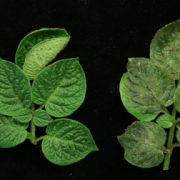Current Biology:
miRNA networks & leaf complexity
Temporal Control of Leaf Complexity by miRNA-Regulated Licensing of Protein Complexes
Ignacio Rubio-Somoza, Chuan-Miao Zhou, Ana Confraria, Claudia Martinho, Patrick von Born, Elena Baena-Gonzalez, Jia-Wei Wang, Detlef Weigel
Current Biology 24, 2714–2719
Highlights
•miR319-targeted TCPs regulate the activity of miR164-(in)dependent CUC proteins
•miR156-targeted SPLs license active transcription factor complexes
•Changes in protein complex composition control age-dependent leaf shape
Summary
The tremendous diversity of leaf shapes has caught the attention of naturalists for centuries. In addition to interspecific and intraspecific differences, leaf morphologies may differ in single plants according to age, a phenomenon known as heteroblasty [ 1 ]. In Arabidopsis thaliana, the progression from the juvenile to the adult phase is characterized by increased leaf serration. A similar trend is seen in species with more complex leaves, such as the A. thaliana relative Cardamine hirsuta, in which the number of leaflets per leaf increases with age. Although the genetic changes that led to the overall simpler leaf architecture in A. thaliana are increasingly well understood [ 2–4 ], less is known about the events underlying age-dependent changes within single plants, in either A. thaliana or C. hirsuta. Here, we describe a conserved miRNA transcription factor regulon responsible for an age-dependent increase in leaf complexity. In early leaves, miR319-targeted TCP transcription factors interfere with the function of miR164-dependent and miR164-independent CUC proteins, preventing the formation of serrations in A. thaliana and of leaflets in C. hirsuta. As plants age, accumulation of miR156-regulated SPLs acts as a timing cue that destabilizes TCP-CUC interactions. The destabilization licenses activation of CUC protein complexes and thereby the gradual increase of leaf complexity in the newly formed organs. These findings point to posttranslational interaction between unrelated miRNA-targeted transcription factors as a core feature of these regulatory circuits.



